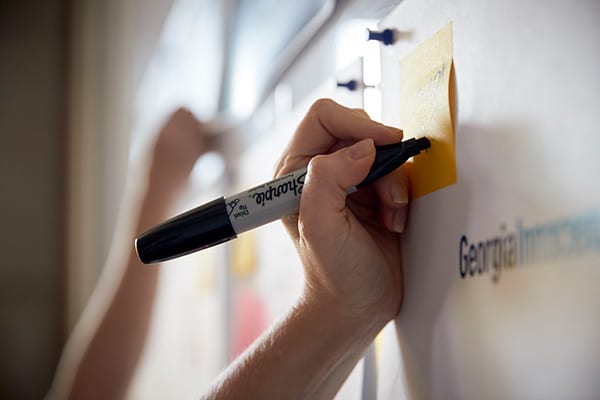4 Principles You Need to Create New Product Names
Creating a new product name is a strategic exercise as much as a creative one, and there are several factors to consider. From functional properties like sound and spelling to more conceptual ones that help you stand apart, the right product name is more than a means of identification but becomes a tool for creating brand recognition, communicating your product’s value, and forming emotional connections with your customers. We’ve named our fair share of products at THRIVE, and to help with the process, we created a set of criteria to help develop names that you — and your customers — will love.
What’s in a name? A lot, actually, at least when it comes to product names. A name is one of the most lasting parts of a brand — it becomes inexorably tied to whatever thing it’s meant to identify in consumers’ minds — so it’s not something to take lightly. But naming products is a lot harder than one might assume. There are a lot of considerations that go into the naming process, and landing on the right one doesn’t happen in a vacuum; you don’t just start coming up with completely random words until something “sounds right.” Sure, a product name should “sound right,” but it should also embody the attributes you want your product to reflect. In other words, it should accentuate what makes your product and your brand distinct, relevant and memorable.
We’ve named our fair share of products at THRIVE, and to help with the process, we created a set of criteria to use when creating and evaluating names.
1. STRATEGIC
Does the product name tell the right story?
The biggest thing to keep in mind during the name development process? Brand strategy. A product name should fit with the brand’s strategy, meaning it aligns with how you’re positioning your products in the marketplace. While it can be purely descriptive of a brand’s value proposition and what a product is or does (e.g. Vitaminwater), it doesn’t have to; you can look to convey the product in more evocative ways, leveraging instead the experience it provides or a customer benefit it represents (e.g. Oracle).
Other important factors to consider here include your target audience: Will the name appeal to the right people? Will your customers understand its meaning? You’ll also want to look at a name’s long-term viability in terms of future growth: Will it continue to describe what you do as you evolve? Will the name flex as the brand extends?
2. FUNCTIONAL
Is the product name evocative, pleasing and simple?
In addition to aligning with your brand, a name should also be easy to say, easy to read, and easy to write. It’s something you want to become solidified in customer’s minds, so you don’t want people to avoid saying your name because they’re not sure how to pronounce it (or because it’s unpleasing to the ear…). Similarly, if someone hears your name, you want them to know how to spell it so they can Google it! This is just not an area to leave room for confusion; keep it simple and intuitive.
Alongside being readable and writable and easy to say out loud, think about how the letters look written down in print. Is the name visually appealing? Might it lend itself to great visual imagery and design?
3. CONCEPTUAL
Does the product name work both creatively and conceptually?
Great names grab your attention. That doesn’t mean they have to be something outlandish, but a name should be unique; you want to stand apart from all the other brands and products in your space. Tap into the psychology of sounds and wordplay to find names that evoke certain visceral responses that might be associated with your brand or product: sharp consonants might equate strength, for example, and alliteration is often used to create a name that’s easy to remember (e.g. PayPal).
Look to your brand personality when brainstorming names as well and make sure names have the appropriate tone, but don’t be afraid to break the rules. A great name is unexpected but fitting (e.g. BlackBerry — not an obvious choice for a mobile phone, but after first considering names related to the word “email,” someone noted the tiny keys on devices resembled a group of seeds, hence BlackBerry).
4. PRACTICAL
Is the product name available?
Sara Blakely often tells the story of landing on the name “Spanx” for her footless hosiery brand founded in 2000; drawn to the “k” sound from two of the world’s most famous brands, Kodak and Coca-Cola, she originally came up with Spanks but replaced the “ks” with an “x” because she knew made-up names were easier to trademark. There’s probably plenty of words in the dictionary yet to be trademarked, but do yourself a favor and research the availability of any names you’re evaluating to make sure no one else owns the trademark. (A good Google search or TESS trademark search is a place to start, but you’ll want a trademark lawyer to finish the job.) You’ll also want to check for domain name availability.
Note that if your brand or product will be used internationally, you’ll have a little extra work to do to make sure it’s legal in other global markets, as well as linguistically and conceptually appropriate beyond our borders.
Contact us today to talk about how we can use our brand strategy expertise to develop names for your new products that you and your customers will love.
People Also Ask These Questions About Product Naming
Q: Why is distinctiveness important in product naming?
- A: Distinctiveness is crucial because it ensures your product name stands out in a crowded marketplace. A unique name can capture attention and make a lasting impression, helping to differentiate your product from competitors.
Q: How does brevity contribute to a good product name?
- A: Brevity contributes to a good product name by making it easier to remember and recognize. Short names are likelier to stick in consumers’ minds, facilitating brand recall and fostering brand loyalty.
Q: Can you give an example of a product name that is both brief and distinctive?
- A: An example of a product name that is both brief and distinctive is “Zoom.” It is short, easy to remember, and its uniqueness helps it stand out in the telecommunications industry.
Q: What does it mean for a product name to be appropriate?
- A: For a product name to be appropriate, it should resonate with the product’s essence, target audience, and brand values. It should fit the product’s identity and appeal to the intended consumers without causing confusion or offense.
Q: Why is easy pronunciation important for a product name?
- A: Easy pronunciation is important because it ensures that consumers can easily share and recommend the product by word of mouth. A name that can be pronounced without difficulty by the target audience enhances its spreadability and market penetration.
Q: Can a product name be creative and easy to pronounce?
- A: Yes, a product name can be creative and easily pronounceable. Creativity does not necessarily complicate pronunciation. For instance, “Google” is a creative yet simple name that has become ubiquitous globally.
Q: What role does the target audience play in product name creation?
- A: The target audience plays a critical role in product name creation, as the name should resonate with their preferences, lifestyles, and cultural contexts. Understanding the target audience ensures the name is appropriate, appealing, and effective in engaging them.
Q: How can I ensure my product name is distinctive in a global market?
- A: To ensure your product name is distinctive in a global market, conduct thorough research, including trademark searches and linguistic checks, to avoid similarities with existing names and ensure the name is culturally sensitive and adaptable across different languages and regions.
Q: Is it necessary to involve professionals in the product naming process?
- A: While not strictly necessary, involving professionals in the product naming process can provide valuable insights, creativity, and expertise, ensuring the name adheres to the principles of distinctiveness, brevity, appropriateness, and easy pronunciation. Professionals can also assist with trademark searches and linguistic analysis to avoid legal and cultural pitfalls.







